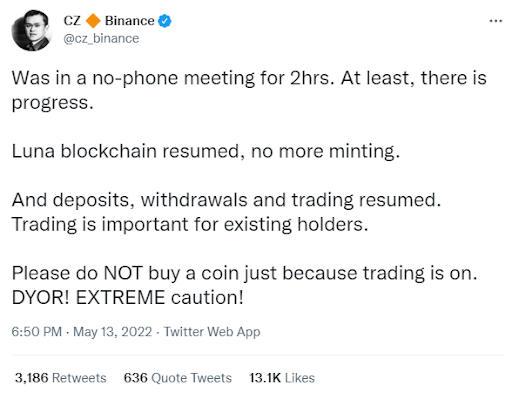Are We Living in a Crypto Bubble: Is It Worth the Risk?

The crypto trading market has been going through a bumpy ride since the beginning of 2022. Recently, Terra, the eighth largest cryptocurrency globally with a market cap worth $25 billion, tanked more than 99.5% of its value in straight-six days. The quick landslide of Luna compelled a massive FUD across all exchanges. As a result, exchanges have halted future and spot trading on Luna.
Things iterated with Bitcoin and alts
Following the de-pegging of Terra's UST, Tether (USDT), the stable coin market leader, lost its peg against the dollar too. Following the USDT's plunge to $0.9455, Bitcoin and Ethereum's prices slumped to $25,359 and $1761.24. Other altcoins, too, lost roughly 40-50% of their values from the previous day following the trail. The Twitter feed went flooded with posts mentioning the bloodbath all around the industry. Many people started speculating that the failure of a Layer 1 blockchain project like Terra could get repeated with other popular coins.
Some started asserting again that the crypto is another dot-com-like bubble and is about to pop soon.
“To the Luna” – the major crash
Take Terra Foundation's ecosystem, for instance. The Luna founder came up with an idea of stablecoin-backed crypto dubbed Luna, and as expected, it received an overnight success, rising to the top-10 listings within a year from nowhere. Why? Because the stablecoin from Terra is quite unlike the popular collateral-backed ones such as USDC or USDT. The UST functioned like other stablecoins to track the price of the dollar, even though it doesn't hold any physical assets such as treasuries to do so.
Instead, UST is an algorithmic stablecoin and gets created by burning Luna via smart contracts and vice versa. So investors could exchange 1 UST with $1 worth of Luna by burning the UST. The Terra ecosystem also had an arbitrage mechanism that allowed investors to profit from everyday price fluctuations. If the demand for UST pushes its price over a dollar, the investors would receive Luna worth the same money. Alongside when the UST price upticks, the investors would burn Luna and create UST to increase its supply. In tandem, the Luna supply decreases and thus makes it rare and more expensive.
The bloodbath happened right after "crypto whales" sold roughly $285 million worth of UST (TerraUSD). They also started short on Luna through various crypto exchange platforms, including Binance, Anchor, and Curve, with a massive outflow resulting in a brief UST de-peg. Once LUNA lost its 1:1 ratio, the price started tanking from $76.51 to $0.0001. So naturally, hundreds and thousands of LUNA and its sister's project coins such as UST and Anchor holders suffered a massive loss. Rumors hint that the UST de-peg started from a coordinated attack through a huge UST sale order resulting in massive liquidity deficiency.
Would the crypto bubble burst?
Most crypto enthusiasts have a firm belief that cryptocurrency is not a bubble. They often argue the immense potential of blockchain and cryptocurrency to validate their claims. Both have the potential to disrupt the industry and prove beneficial for most businesses and personal use. Ironically, the past bubbles like the 2000s internet one happened because technology has immense potential for disruption. But the bubble bursts whenever the speculation around the technology fails to meet the exception concerning the real-life application.
Terra Foundation failed despite having incredible tokenomics because of a worst-case scenario they weren't prepared for. As you know, similar things happened during the Internet bubble. During the mid-1990s, dot com IPOs mushroomed in the US just like today's ICOs. Many companies accumulated millions of dollars without proving anything related to success. In early 2000 it happened what was supposed to happen. NASDAQ nosedived, and big tech companies like Apple and Amazon plummeted and took a few years to recover.
Like the Internet, blockchain or distributed ledger technology (DLT) can revolutionize every sphere of life. The technology can potentially disrupt the supply chain, Internet-of-Things, finance, healthcare, shipping, production, aviation, journalism, contracts, etc. And this colossal expectation forms the bubble, as it happened with the early ages of the internet because it meets both the primary criteria of a bubble – a widespread disruption but has been applied on a few spectrums, and you can't figure out the actual value of it. The massive adoption, according to our perception, will take some time because it too will encounter several challenges like every other new technology. And this will take some time. So, naturally, it will fall short of the massive expectation. And then the bubble explodes.
Unlike in 2000s, buyers can accumulate more information on what they are investing via the Internet. But everyday FOMO around many new crypto projects proves how most available information is mere marketing campaigns. The exchanges suffer less regulation on insider trading and market manipulation, resulting in crazy arbitrage. In addition, crypto whales can easily manipulate a blockchain's pricing by having less daily trading volume.
After a brief suspension on LUNA and UST pairs, Binance restarted the trading after a prolonged 2-hour meeting with some undisclosed parties. However, Chanpeng Zhao, Binance CEO, has cautioned traders to be extremely cautious while buying this trading pair.

For now, millions of buyers have started buying LUNA, UST, and Anchor Protocol crypto at a reduced rate. They are buying with the hope that these coins rise like Phoenix from the ashes and make them rich, because they hope there is always a light at the end of the tunnel. Who knows if LUNA can get back as Ethereum did in 2018, but they prefer not to do any research before placing their trades, strangely similar to the dot com boom.
Being cautious
But we wish history doesn't repeat itself. Because blockchain and cryptocurrency have the potential to transform the world in many aspects and could compete with the equity market. Decentralization, virtual digital assets, and DLT could transform many other things that we could only imagine today. It is all possible, but it will take time. This period is long, and the road is full of thorns. We have to hold our breath and sail through many bear markets to end the journey into a beautiful one.